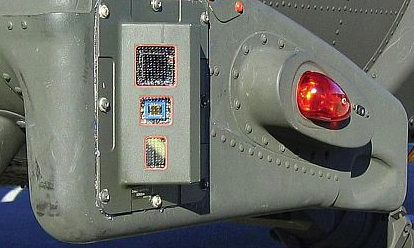Home
A comprehensive resource for safe and responsible laser use
US: $208 million contract to protect Army helicopters from laser threats
The Army/Navy Piloted Aircraft/Visual and Visible Light/Receiving, Passive Detecting (AN/AVR-2B) Laser Detecting Sets (LDS) uses four sensor units placed on the aircraft. It is smaller, lighter and uses less power than a previous generation developed for the cancelled Comanche helicopter program.
News reports did not state how much it costs to equip each helicopter with an AN/AVR-2B system.

One of the four sensor packages to detect laser threats on U.S. military helicopters
From Avionics Intelligence August 31 2013 and September 3 2013
US: Pentagon delayed using laser dazzers in Iraq
During the U.S. phase of the Iraq war, Marine Corps leaders requested the handheld devices as a way to warn and stop drivers who were overrunning military checkpoints. Wired’s David Axe estimates that “as many as 50” Iraqi civilians were killed by gunfire -- instead of being forced off the road by dazzlers -- during the nine month delay.
There is some dispute over the safety of laser dazzlers. According to the Inspector General’s report,
Laser dazzlers provide a nonlethal capability by emitting an intense light capable of temporarily obscuring the vision of approaching individuals; however, using lasers poses a risk of serious eye injury and permanent blindness. This mode of employing a laser, shining a laser directly into the face or eyes, increases the inherent dangers of using the laser. Using nonlethal laser dazzlers would give Marine operating forces an additional capability to increase stand-off distances, safeguard civilians who venture too close to Marine positions, and help prevent unwarranted escalation of force incidences; however, DoD [Department of Defense] policy prohibits the use of lasers designed to cause permanent blindness. Operating procedures and laser safety measures are essential to ensure the safe and proper use of the lasers.
The Inspector General’s report contains additional details about the range, capabilities, safety concerns and policy issues related to military use of laser dazzlers. For example, the 1995 Protocol on Blinding Laser Weapons states that the signatories (which include the U.S.) “shall take all feasible precautions to avoid the incidence of permanent blindness to unenhanced vision.”
From Wired.com.